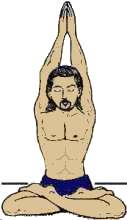Technique of Parvatasana :
- Sit erect in Padmasana.
- Form a firm finger lock.
- Inhaling, stretch the arms with the finger lock vertically above the head without raising the seat and knees.
- Exhale.
- Inhaling again, stretch your arms upwards from the shoulder blades and stretch the trunk to the maximum without moving from your seat.
- Maintain this posture, holding your breath.
- Exhaling, resume the starting position.
- As both the arms are kept vertically up in this asana, the "Prana" is sublimated.
- This makes spine flexible.
- Visceroptosis and pain in backbone is removed.
- This asana gives sufficient exercise to the muscles of the arms.
- It is beneficial in constipation and removes seminal weakness.
- If Suryabheda pranayama or Anuloma-Viloma pranayama is practiced for fifteen minutes before performing this asana, the lungs, the abdomen and the spine become strong and healthy.
- Those, who cannot practice Padmasana, can practice it in standing, stretched legs or Vajrasana.
- Those having complaints of reeling sensation should not practice it.






No comments:
Post a Comment